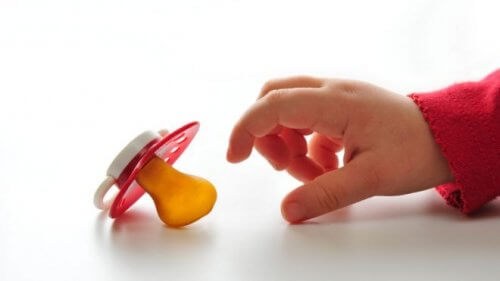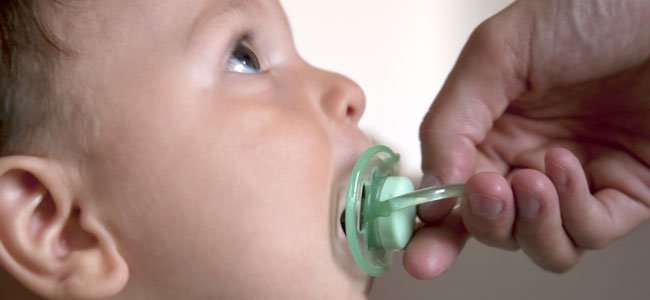Consequences of Excessive Pacifier Use

Although pacifiers can positively accompany children during their first years of life, they can also have negative consequences. That is, excessive pacifier use can end up harming your child. We’ll tell you how below.
Why it is good to avoid excessive pacifier use
Retreating at the right time is a victory. In other words, we must prevent excessive pacifier use past the time when it is truly necessary so that it does not become a problem.
Why? Here are the reasons.
It could make breastfeeding difficult
It is not the same to suck on a plastic pacifier as it is to suckle at the mother’s breast.
If the baby is still learning to breastfeed, it is not advisable to put anything else in his mouth in order to avoid confusing him. The little one does not move his tongue the same way and will not know what to do.
This is called nipple confusion syndrome. This problem can be caused by pacifiers and by the use of different teats. This is the main reason why its use is not recommended until breastfeeding is a routine known and established by the baby.
It can promote mouth infections
The use of a pacifier can cause certain infections to appear in the mouth. In general, one of the most frequent infections is caused by fungi, known as the muguett. It is a disease caused by Candida albicans.
Cavities are another risk, although many are unaware of it. Excessive pacifier use can cause so-called baby bottle cavities.

It can cause teeth abnormalities
Prolonged use of pacifiers can also cause certain abnormalities in the teeth. This is because the child ends up developing deformities in his jaw. In particular, it can cause the upper arch to be in front of the lower arch, which is called malocclusion.
Another problem that can be found in this regard is that the upper teeth do not fit with those below, which is called an open bite.
This open bite occurs, above all, when pacifiers with a hard central axis are used. Also, when a baby is using it, he usually breathes through his mouth and not through his nose.
All of this encourages the appearance of abnormalities on the palate. It also favors the appearance of deformities in the oral cavity.
Speech disorders
Excessive pacifier use will also affect language development. In order to have proper articulation, it is necessary for children to not have malformations in the mouth.
These disorders can be corrected. However, additional problems would be to pronounce certain sounds poorly.
May cause ear infections
An ear infection could occur when the baby breathes through his mouth, as previously mentioned. In that case, the Eustachian tube does not close when saliva is swallowed.

How to avoid these problems
To prevent your baby from having these problems, the following should be taken into account, in addition to trying to not use a pacifier for a long time throughout the day:
- Pacifiers should definitely not be used past the age of 2 or 3. This will avoid malformations in the mouth.
- It is important to take into account the child’s maturity in order to avoid traumatic situations. For example, it is not advisable to take away pacifiers at the same time as diapers. Usually from that moment on, it is the boys who demand the pacifier at certain times.
- In any case, you should keep in mind that the need for suction disappears in children by the age of 4. From this moment on, they will not suffer even if they miss their pacifier.
It is advisable to take note of these tips and ways to avoid problems related to excessive pacifier use, which can cost a lot to remedy.
All cited sources were thoroughly reviewed by our team to ensure their quality, reliability, currency, and validity. The bibliography of this article was considered reliable and of academic or scientific accuracy.
- Asociación Española de Pediatría. Uso del chupete y lactancia materna. 2011. Disponible en: https://www.aeped.es/comite-lactancia-materna/documentos/uso-chupete-y-lactancia-materna
- Álvarez Hernández, C., Barcia Varas, J., Pavez Gallegos, N., & Zúñiga Delgado, C. (2015). Descripción de reflejos orofaciales, succión nutritiva y no nutritiva en lactantes prematuros extremos de 3 y 6 meses de edad corregida. http://repositorio.uchile.cl/bitstream/handle/2250/138230/Álvarez%20Barcia%20Pavez%20Zúñiga.pdf?sequence=1&isAllowed=y
- Diaz Coronado, V. N. (2018). EFICACIA DEL USO DEL CHUPETE EN LA DISMINUCIÓN DE LA MUERTE SÚBITA EN LACTANTES. http://repositorio.uwiener.edu.pe/bitstream/handle/123456789/2026/ESPECIALIDAD%20-%20Diaz%20Coronado%2c%20Vilma%20Nerida.pdf?sequence=1&isAllowed=y
- Asociación Española de Pediatría. (n.d.). Chupere. https://enfamilia.aeped.es/edades-etapas/chupete
- Varas, V. F., & Gil, B. G. (2012, December). Hábito de succión del chupete y alteraciones dentarias asociadas. Importancia del diagnóstico precoz. In Anales de Pediatría (Vol. 77, No. 6, pp. 374-380). Elsevier Doyma. https://www.google.com/url?sa=t&rct=j&q=&esrc=s&source=web&cd=&cad=rja&uact=8&ved=2ahUKEwir6Ijqxv_rAhUF2uAKHd25C2MQFjACegQIBRAB&url=https%3A%2F%2Fwww.analesdepediatria.org%2Findex.php%3Fp%3Drevista%26tipo%3Dpdf-simple%26pii%3DS1695403312001518&usg=AOvVaw34bQh3N6vKYwbb2nh6idzq
- Sánchez, L. M., González, E. D., Florensa, S. G. T., & Marti, J. G. (2000, January). Uso del chupete: beneficios y riesgos. In Anales de Pediatría (Vol. 53, No. 6, pp. 580-585). Elsevier Doyma. https://www.analesdepediatria.org/es-pdf-S1695403300775023
This text is provided for informational purposes only and does not replace consultation with a professional. If in doubt, consult your specialist.








